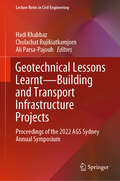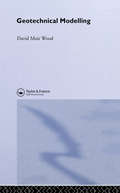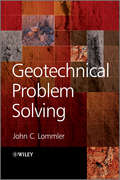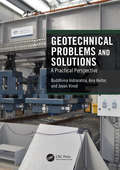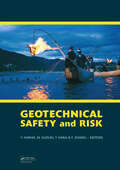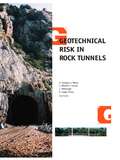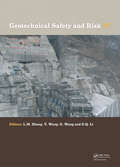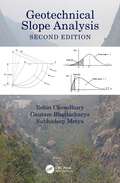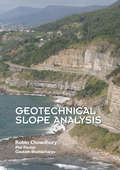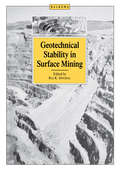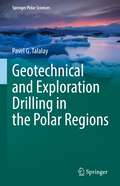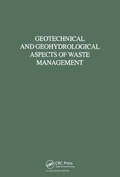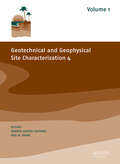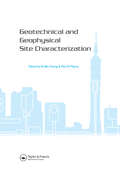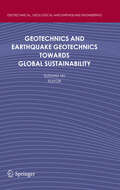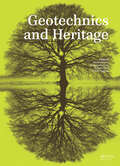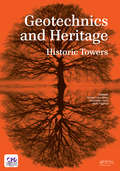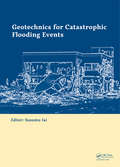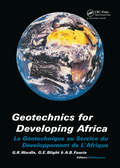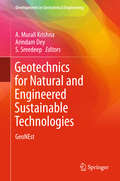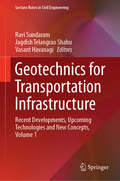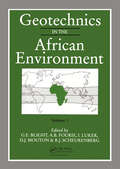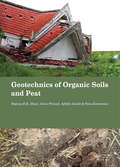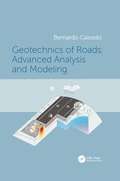- Table View
- List View
Geotechnical Lessons Learnt—Building and Transport Infrastructure Projects: Proceedings of the 2022 AGS Sydney Annual Symposium (Lecture Notes in Civil Engineering #541)
by Hadi Khabbaz Cholachat Rujikiatkamjorn Ali Parsa-PajouhThis book presents the select proceedings of the 26th Annual Symposium organized by the Sydney Chapter of the Australian Geomechanics Society (AGS). The symposium brought together key stakeholders of the Australian geological and geotechnical community. This book showcases state-of-the-art practices, new research findings, and case histories that demonstrate reliability-based designs and assessments. The papers on reliability-based approaches cover various aspects of site investigations, interpretations, designs, specialized testing, and technologies. This book presents recent innovations, trends, and concerns, as well as practical challenges encountered, and solutions adopted in the field. This volume will be a useful guide to those in academia and industry working in the fields of geotechnical engineering.
Geotechnical Modelling
by David Muir Wood<p>Modelling forms an implicit part of all engineering design but many engineers engage in modelling without consciously considering the nature, validity and consequences of the supporting assumptions. Derived from courses given to postgraduate and final year undergraduate MEng students, this book presents some of the models that form a part of the typical undergraduate geotechnical curriculum and describes some of the aspects of soil behaviour which contribute to the challenge of geotechnical modelling. <p>Assuming a familiarity with basic soil mechanics and traditional methods of geotechnical design, this book is a valuable tool for students of geotechnical and structural and civil engineering as well as also being useful to practising engineers involved in the specification of numerical or physical geotechnical modelling.</p>
Geotechnical Problem Solving
by John C. LommlerDevised with a focus on problem solving, Geotechnical Problem Solving bridges the gap between geotechnical and soil mechanics material covered in university Civil Engineering courses and the advanced topics required for practicing Civil, Structural and Geotechnical engineers. By giving newly qualified engineers the information needed to apply their extensive theoretical knowledge, and informing more established practitioners of the latest developments, this book enables readers to consider how to confidently approach problems having thought through the various options available. Where various competing solutions are proposed, the author systematically leads through each option, weighing up the benefits and drawbacks of each, to ensure the reader can approach and solve real-world problems in a similar mannerThe scope of material covered includes a range of geotechnical topics, such as soil classification, soil stresses and strength and soil self-weight settlement. Shallow and deep foundations are analyzed, including special articles on laterally loaded piles, retaining structures including MSE and Tieback walls, slope and trench stability for natural, cut and fill slopes, geotechnical uncertainty, and geotechnical LRFD (Load and Resistance Factor Design).
Geotechnical Problems and Solutions: A Practical Perspective
by Buddhima Indraratna Ana Heitor Jayan S. VinodThis book covers problems and their solution of a wide range of geotechnical topics. Every chapter starts with a summary of key concepts and theory, followed by worked-out examples, and ends with a short list of key references. It presents a unique collection of step by step solutions from basic to more complex problems in various topics of geotechnical engineering, including fundamental topics such as effective stress, permeability, elastic deformation, shear strength and critical state together with more applied topics such retaining structures and dams, excavation and tunnels, pavement infrastructure, unsaturated soil mechanics, marine works, ground monitoring. This book aims to provide students (undergraduates and postgraduates) and practitioners alike a reference guide on how to solve typical geotechnical problems. Features: Guide for solving typical geotechnical problems complementing geotechnical textbooks. Reference guide for practitioners to assist in determining solutions to complex geotechnical problems via simple methods.
Geotechnical Risk and Safety: Proceedings of the 2nd International Symposium on Geotechnical Safety and Risk (IS-Gifu 2009) 11-12 June, 2009, Gifu, Japan - IS-Gifu2009
by F. Zhang M. Suzuki Y. Honjo T. HaraCommunication of risks within a transparent and accountable framework is essential in view of increasing mobility and the complexity of the modern society and the field of geotechnical engineering does not form an exception. As a result, modern risk assessment and management are required in all aspects of geotechnical issues, such as planning, desi
Geotechnical Risk in Rock Tunnels: Selected Papers from a Course on Geotechnical Risk in Rock Tunnels, Aveiro, Portugal, 16-17 April 2004
by A. Campos e Matos, L. Ribeiro e Sousa, J. Kleberger & P. Lopes PintoTunnels have a high degree of risk that needs to be assessed and managed. Underground works intersect and interact with natural materials, incorporating their characteristics as structural components of their own stability. For this reason geotechnical risk analyses are implemented at all phases of tunnel construction, from design through to post-c
Geotechnical Safety and Risk IV
by Y. Wang G. Wang L. M. Zhang D. Q. LiGeotechnical Safety and Risk IV contains the contributions presented at the 4th International Symposium on Geotechnical Safety and Risk (4th ISGSR, Hong Kong, 4-6 December 2013), which was organised under the auspices of the Geotechnical Safety Network (GEOSNet), TC304 on Engineering Practice of Risk Assessment and Management and TC205 on Safety an
Geotechnical Slope Analysis
by Gautam Bhattacharya Robin Chowdhury Subhadeep MetyaThis second edition of Geotechnical Slope Analysis is an updated version of the original scholarly book. In this edition, concepts and applications have been thoroughly revised. In particular, the ‘Initial Stress Approach’ has been extended to 2D problems in a more rigorous manner. Additional solved numerical examples have been added in several chapters. More importantly, the meaning of the results is explored through interpretation. The influence of initial stresses, pore water pressures and seismic forces has been explored not only on performance indicators such as the ‘Factor of Safety’ but also on the location of critical slip surfaces. In addition to these factors, it is shown that the chosen method of analysis may also have a significant influence on the location of the critical slip surface. Student exercises have been included in some chapters with a view to encouraging further study and research, and reference is often made to case studies of particular importance. The best features of the book have been retained with continued emphasis on both deterministic and probabilistic approaches for quantifying slope performance. The traditional performance indicator such as ‘Factor of Safety’ can be complemented by the calculation of the ‘Reliability Index’ and the ‘Probability of Failure’. This book focuses on research studies concerning slope behaviour, the occurrence of landslides and the use of alternative methods of analysis and interpretation. The importance of uncertainties in slope performance and, more broadly, in geotechnical engineering is emphasised. This book will be valuable to undergraduate and senior students of civil, mining and geological engineering as well as to academic teachers and instructors and also to researchers, practising geotechnical engineers and consultants.
Geotechnical Slope Analysis
by Gautam Bhattacharya Robin Chowdhury Phil FlentjeFreshly updated and extended version of Slope Analysis (Chowdhury, Elsevier, 1978). This reference book gives a complete overview of the developments in slope engineering in the last 30 years. Its multi-disciplinary, critical approach and the chapters devoted to seismic effects and probabilistic approaches and reliability analyses, reflect the distinctive style of the original. Subjects discussed are: the understanding of slope performance, mechanisms of instability, requirements for modeling and analysis, and new techniques for observation and modeling. Special attention is paid to the relation with the increasing frequency and consequences of natural and man-made hazards. Strategies and methods for assessing landslide susceptibility, hazard and risk are also explored. Moreover, the relevance of geotechnical analysis of slopes in the context of climate change scenarios is discussed. All theory is supported by numerous examples.''...A wonderful book on Slope Stability....recommended as a refernence book to those who are associated with the geotechnical engineering profession (undergraduates, post graduates and consulting engineers)...'' Prof. Devendra Narain Singh, Indian Inst. of Technology, Mumbai, India''I have yet to see a book that excels the range and depth of Geotechnical Slope Analysis... I have failed to find a topic which is not covered and that makes the book almost a single window outlet for the whole range of readership from students to experts and from theoreticians to practicing engineers...'' Prof. R.K. Bhandari, New Delhi, India
Geotechnical Stability in Surface Mining
by Raj. K. SinghalThis book presents the proceedings of the international symposium on geotechnical stability in surface mining in Calgary. The symposium deals with the full gamut of mine equipment development, selection and utilization.
Geotechnical and Exploration Drilling in the Polar Regions (Springer Polar Sciences)
by Pavel G. TalalayThis book provides a comprehensive review of drilling technologies in the polar regions, from the portable drilling equipment for shallow sampling and coring, to heavy drilling equipment for deep onshore and offshore drilling. Particular attention is given to safe drilling methods in permafrost. In recent years, interest in drilling in the polar regions has increased under the pressure of the geopolitical “rush” and the undiscovered resource potential. In addition, borehole monitoring of permafrost thermal states is urgently needed to obtain evidence of climate change. The book focuses on the latest drilling technologies but also discusses the historical development of sampling, and drilling tools and devices, over the last 60–70 years providing valuable insights into a way forward and future possibilities.
Geotechnical and Geohydrological Aspects of Waste Management: Proceedings of Eighth Symposium
by Fort CollinsThis monograph contains the proceedings of the 9th Annual Symposium on Geo-aspects of Waste Management, February 1-6, 1987 held at Colorado State University, Fort Collins, Colorado.
Geotechnical and Geophysical Site Characterization 4: Proceedings Of The 3rd International Conference On Site Characterization (isc'3, Taipei, Taiwan, 1-4 April 2008). Book Keynote Papers (258 Pages) + Cd-rom Full Papers (1508 Pages)
by Roberto Quental Coutinho Paul W. MayneSite characterization is a fundamental step towards the proper design, construction and long term performance of all types of geotechnical projects, ranging from foundation, excavation, earth dams, embankments, seismic hazards, environmental issues, tunnels, near and offshore structures. Geotechnical and Geophysical Site Characterization 4 provides practical applications of novel and innovative technologies in geotechnical and geophysical engineering, and is of interest to academics, engineers and professionals involved in Geotechnical Engineering.
Geotechnical and Geophysical Site Characterization: Proceedings of the 3rd International Conference on Site Characterization (ISC'3, Taipei, Taiwan, 1-4 April 2008). BOOK Keynote papers (258 pages) + CD-ROM full papers (1508 pages)
by An-Bin Huang Paul W. MayneGeotechnical and Geophysical Site Characterization collects the papers presented at the Third International Conference on Site Characterization (ISC 3) that took place in Taipei from April 1-4, 2008. The subjects covered include new developments in mechanical in-situ testing and interpretation techniques, statistical analysis of test data, geo
Geotechnics and Earthquake Geotechnics Towards Global Sustainability
by Susumu IaiThis book is part of a bold, new initiative towards global sustainability and development that draws on the disciplines of geotechnical engineering and earthquake geotechnics. It contains contributions from fifteen of the world's leading experts who met in Kyoto in early 2010 to discuss a range of issues related to the ways geotechnics can help us face the challenges ahead, from the technical to the social, from geo-hazards to megacities, from global warming and coastal protection to the conservation of world heritage sites. We hope these contributions will stimulate the debate over the role geotechnics has to play in achieving a more sustainable future for the world. Audience This book will be of interest to advanced levels of researchers and practicing engineers in the fields of geotechnics and earthquake geotechnics for global sustainability: the greatest long term challenge of our time.
Geotechnics and Heritage: Case Histories
by Alessandro Flora Carlo Viggiani Emilio Bilotta Stefania LirerConservation of monuments and historic sites is one of the most challenging problems facing modern civilization. It involves various cultural, humanistic, social, technical, economical and administrative factors, intertwining in inextricable patterns. The complexity of the topic is such that guidelines or recommendations for intervention techniques
Geotechnics and Heritage: Historic Towers
by Renato Lancellotta Alessandro Flora Carlo ViggianiConservation of monuments and historic sites is one of the most challenging problems facing modern civilization. It involves various cultural, humanistic, social, technical, economical and administrative factors, intertwining in inextricable patterns. The complexity of the topic is such that guidelines or recommendations for ntervention techniques and design approaches are difficult to set. <P><P>The Technical Committee on the Preservation of Monuments and Historic Sites (named TC19) was established by the International Society of Soil Mechanics and Geotechnical Engineering (ISSMGE) in 1981, is supported by the Italian Geotechnical Society (AGI), and was renamed TC301 in 2010. <P><P>This book assesses the role of historic towers as symbols of community identity and how to best preserve this special cultural heritage. Well-documented, exemplary case histories highlight concepts of preservation, integrity, cultural heritage, dynamic identification techniques and techniques for long-term monitoring of historic towers, as well as provide examples of appropriate intervention measures. <P><P>The book will be of interest to professionals and academics in the wider fields of civil engineering, architecture and cultural resources management, and particularly those involved in art history, history of architecture, geotechnical engineering, structural engineering, archaeology, restoration and cultural heritage management.
Geotechnics for Catastrophic Flooding Events
by Susumu IaiGeotechnics for Catastrophic Flooding Events presents the keynote lectures (book, 264 pages) and keynote lectures and general papers (CD-ROM, 608 pages) presented at the Fourth International ISSMGEConference on Geotechnical Engineering for Disaster Mitigation and Rehabilitation (4th GEDMAR, Kyoto, Japan, 16-18 September 2014). The contributions dis
Geotechnics for Developing Africa: Proceedings of the 12th regional conference for Africa on soil mechanics and geotechnical engineering, Durban, South Africa, 25-27 October 1999
by G.R.Wardle; G.E.Blight; A.B.FourieThe proceedings represent a valuable reference on geotechnical problems peculiar to Africa and for engineering solutions to local problems. Topics covered are: Foundation engineering and lateral support; Methods of design and analysis; Monitoring, laboratory and field testing; Municipal, industrial and mining waste and environmental geotechnics; Soil improvement; Transportation geotechnics; Case studies.The proceedings are also an invaluable source of data on the properties of African soils, the properties of residual and tropical soils, as well as climate related problems.
Geotechnics for Natural and Engineered Sustainable Technologies: Geonest (Developments in Geotechnical Engineering)
by A. Murali Krishna Arindam Dey S SreedeepThis contributed volume encompasses contributions by eminent researchers in the field of geotechnical engineering. The chapters of this book are based on the keynote and sub-theme lectures delivered at the Indian Geotechnical Conference 2017. The book provides a comprehensive overview of the current state-of-the-art research and practices in different domains of geotechnical engineering in the areas of soil dynamics, earth retaining structures, ground improvement, and geotechnical and geophysical investigations. It will serve as an ideal resource for academics, researchers, practicing professionals, and students alike.
Geotechnics for Transportation Infrastructure: Recent Developments, Upcoming Technologies and New Concepts, Volume 1 (Lecture Notes in Civil Engineering #28)
by Ravi Sundaram Jagdish Telangrao Shahu Vasant HavanagiThis book presents selected papers from the International Symposium on Geotechnics for Transportation Infrastructure (ISGTI 2018). The research papers cover geotechnical interventions for the diverse fields of policy formulation, design, implementation, operation and management of the different modes of travel, namely road, air, rail and waterways. This book will be of interest to academic and industry researchers working in transportation geotechnics, as also to practicing engineers, policy makers, and civil agencies.
Geotechnics for Transportation Infrastructure: Recent Developments, Upcoming Technologies and New Concepts, Volume 2 (Lecture Notes in Civil Engineering #29)
by Ravi Sundaram Jagdish Telangrao Shahu Vasant HavanagiThis book presents selected papers from the International Symposium on Geotechnics for Transportation Infrastructure (ISGTI 2018). The research papers cover geotechnical interventions for the diverse fields of policy formulation, design, implementation, operation and management of the different modes of travel, namely road, air, rail and waterways. This book will be of interest to academic and industry researchers working in transportation geotechnics, as also to practicing engineers, policy makers, and civil agencies.
Geotechnics in the African Environment, volume 1: Proceedings of 10th regional conference for Africa on soil mechananics foundation engineering & the 3rd international conference tropical & residual soils, Maseru, 23-27 September 1991, 2 volumes
by G.E.BLIGHT; A.B.FOURIE; I.LUKER; D.J.MOUTON; R.J.SCHEURENBERGProceedings of the 10th Regional Conference for Africa on Soil Mechanics and Foundation Engineering and the 3rd International Conference on Tropical and Residual Soils, held in Maseru, Lesotho, September 1991, are contained in two volumes. The papers address geotechnical problems peculiar to Africa and engineering solutions for local problems, as well as data on the properties of African soils.
Geotechnics of Organic Soils and Peat
by Bujang B.K. Huat Arun Prasad Sina Kazemian Afshin AsadiPeat and organic soils commonly occur as extremely soft, wet, unconsolidated surficial deposits that are an integral part of wetland systems. These types of soils can give rise to geotechnical problems in the area of sampling, settlement, stability, in situ testing, stabilisation and construction. There is therefore a tendency to either avoid build
Geotechnics of Roads: Advanced Analysis and Modeling
by Bernardo CaicedoAt first glance, roads seem like the simplest possible geotechnical structures. However, analysis of these structures runs up against complexities related to the intense stresses experienced by road surfaces, their intense interaction with climate, and the complicated behavior of the materials used in road construction. Modern mechanistic approaches to road design provide the tools capable of developing new technical solutions. However, use of these approaches requires deep understanding of the behavior of constituent materials and their interaction with water and heat which has recently been acquired thanks to advances in geotechnical engineering. The author comprehensively describes and explains these advances and their use in road engineering in the two-volume set Geotechnics of Roads, compiling information that had hitherto only been available in numerous research papers. Geotechnics of Roads: Advanced Analysis and Modeling develops 23 extended examples that cover most of the theoretical aspects presented in the book Geotechnics of Roads: Fundamentals. Moreover, for most examples, Volume 2 describes algorithms for solving complex problems and provides Matlab® scripts for their solution. Consequently, Volume 2 is a natural complement of the book Geotechnics of Roads: Fundamentals. This unique book will be of value to civil, structural and geotechnical engineers worldwide.
